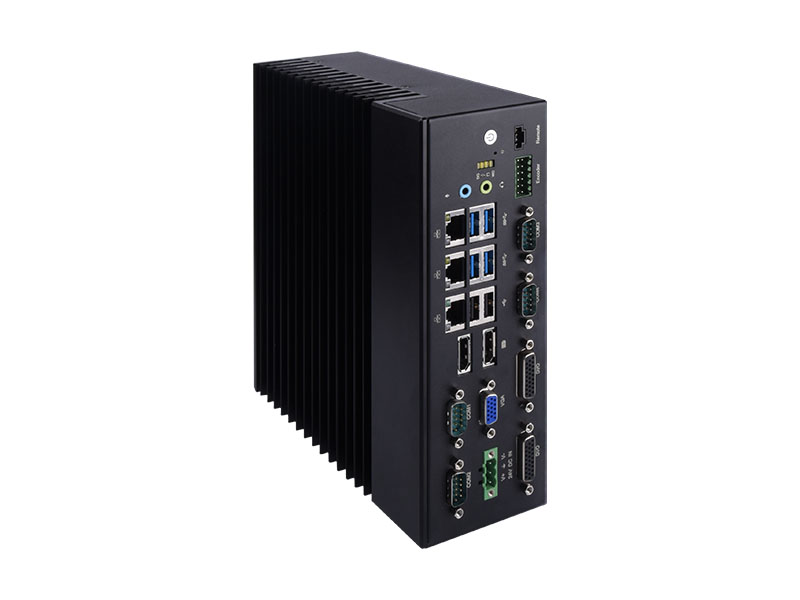Optimizing Intel x86 Fanless Embedded Computer platform to enhance automated inspection and detection
With the continuous development of manufacturing, advanced concepts and technologies such as Industry 4.0 and Internet of Things (IIoT) are gradually being integrated into manufacturing. To put it simply, the development of technology will make the operation of future industrial manufacturing production lines more accurate and efficient, and even eventually achieve intelligent adaptive production without human intervention, completely freeing human resources from the production line. This is undoubtedly a very beautiful vision. The industry is also making unremitting efforts to realize this beautiful vision at an early date.
New requirements for modern manufacturing
In order to meet the highly automated production environment such as Industry 4.0 and Industrial Internet of Things, higher requirements are imposed on the equipment on the production line. They must operate accurately, respond quickly, and work closely together. In such a highly automated production process, the deployment of machine vision technology is essential. In the production environment of the Industrial Internet of Things, equipment undertakes a large number of production tasks every day. Each highly automated production process, from material processing to product assembly, packaging, and logistics, relies on machine vision to reliably identify various objects in the production process, helping the system to make correct response decisions quickly, thereby improving production efficiency. Reduce the complexity of your workflow. Machine vision solution achieves accurate and reliable recognition rates in the execution of various production tasks.
Defect detection is the most difficult type of challenge in machine vision applications. The biggest challenge of defect detection is that it is different from the identification and detection of some known features. In the actual production process, what specific defects will occur in the product is often unpredictable, such as the Scratches are diverse. In this case, it is difficult to use the established methods in traditional machine vision inspection to detect these randomly occurring and unpredictable defects. Therefore, up to now, the last hurdle of many defect detections has still to be identified by human eyes. Manual visual inspection still dominates the quality control process. So, how to make the production system accurately and efficiently detect these unpredictable defects without the help of human eyes can be said to be one of the most intractable problems in the field of machine vision inspection. To solve such problems, machines need to have the learning ability similar to the "human brain", as well as the ability to analyze and deal with problems.
Relevant technologies
Artificial intelligence opens a new era in machine vision
As a sub-field of AI, deep learning can enable devices on the production line to have autonomous learning capabilities. It is no longer "very mechanically executing a set of instruction", but can be like a human being in the actual production process with analysis, judgment and reasoning ability, to "build the road through the mountains, bridge the road over water", paving the way for the construction of intelligent manufacturing plants.
The deep learning deployment of the Intel OpenVINO tool suite optimizes the trained model, performs inference analysis, and provides an API for applications to send data to the inference engine. With the optimization of the OpenVINO, the inference performance will be significantly improved, and the benchmark results will be significantly improved.
ü Run multiple instances of the OpenVINO, each of which is tied to one or more cores, which helps improve core utilization.
ü Reduce time to market with libraries and pre-optimized kernels.
ü Include optimized calls for OpenCV and OpenVX.
The OpenVino SDK is a toolkit launched by Intel specifically to simplify deep learning development. It can help developers deploy trained models to the target platform for inference. One of the benefits of OpenVINO is that it can write a program and then choose to run on various Intel hardware based on the workload. For example, the same deep learning model can run on Intel Xeon, Atom, Core and other processors.
Bring powerful computer vision technology to new places with revolutionary Intel® Vision products. With the right performance, cost, and power efficiency at every node, you can scale vision technology across your infrastructure and unlock new possibilities for visual data. Intel Vision products including the Intel OpenVINO toolkit accelerate the capabilities of IoT vision systems and deep learning inference where you need it - from the camera to the cloud. This gives you insights at the right place and time, so you can make decisions faster and implement new operational strategies to drive immediate results.
Solution for Inspection & Detection of SMT welding
Pain points and problems customer facing
1. After the antenna is welded by automatic welder, the yield of welding spot need to be checked manually. And there was no image analysis of the cause of poor welding.
2. Manually inspection of the overall appearance yield and HDMI connector appearance defects
3. Manually inspection by antenna patch station: whether the antenna is missing & pasting position & polarity
Manually inspection by foam paste station: whether the foam is missing & sticking position
Manually inspection by HDMI placing station checking on placing of HDMI connector
4. Manually inspection by HDMI connector brush solder paste station checking on flux and solder paste volume and uniformity
Manually inspection by the thermal paste dispensing station checking on the volume and uniformity of the thermal grease.
5. Evaluation to replace the original barcode scanning solution of one famous brand into its own low-cost solution
Enabling deep learning capabilities for traditional machine vision, the system will have the following key capabilities:
ü Training: Collect image data and use existing image data to build models of target objects and their attributes in a high-performance server environment.
ü Reasoning: Deploy trained models in a factory environment to evaluate and identify such models that appear in new images (such as identifying text or detecting defects).
ü Retraining: If the production environment changes, such as deviations in optics, lighting, or product specifications, the data distribution may change. The retraining process will collect new images and then update the model.
Problem solved
1. Insufficient soldering: accurately distinguish between good welding and insufficient of tin, and the judgment result is credible. The detection rate was over 99%
2. Excess soldering: accurately distinguish between good welding and excess of tin, and the judgment result is credible. The detection rate was over 99%
3. Missing soldering: accurately distinguish between good welding and missing of tin, and the judgment result is credible. The detection rate was over 99%
4. Missing parts: it is more accurately to distinguish between good welding and missing parts, but there will be cases where the empty welds are simultaneously rejected as missing parts, and the detection rate is about 99%.
Solution
According to above needs from customer, Future Robot Tehcnology Co., Ltd recommended E510 series Vision Controllerwith following features which fulfilled our customer needs and evaluate the result of design win.
ü Ultra-Compact size, easy to install into flexible positions in tight spaces
ü Intel® Core 6/7/8th Gen i5/i3 CPU supports high performance
ü Good compatibility, low error rate, support external network equipment
ü Easy maintenance, high reliability, data & information sharing
ü Highly integrated with isolated 32DIO and 6 light control output helping customer on high efficiency, saving extra devices and saving maintenance charges
ü Intel Ethernet Controller i211 supports strongly for 2 GigE Vision cameras
ü Support OpenVINO

Figure 1. E510 series Fanless Embedded Computer. (Source: Future Robot Technology Co., Limited)
E510 series Fanelss Embedded Computer is a highly integrated, high-performance, ultra-compact professional Vision Controller, ideally suitable in Barcode Recognition, Defect Inspection, Size Measurement, Positioning and Guidance applications.

Future Robot Technology Co., Limited (Future Robot in short) is a high-tech innovation enterprise focusing on Intelligent Manufacturing and Artificial Intelligence. Future Robot, with strong R&D capability and market demand-orientation, design and provide worldwide enterprises and individual users with embedded products which are for Industrial Automation, Robot, Machine Vision, Medical Application, Intelligent Transportation, Education and Internet of Things applications.
Expert team with rich experiences in Machine Vision, Motion Control and Edge Computing:
Hardware engineering team
- x86, FPGA, DSP, Layout and testing Engineers
Software engineering team
- BIOS engineers, FPGA, DSP, Algorithm software engineers and system development engineers.
Industrial and structure design engineering team
- structure design, multi board and model design

As a member of Intel IoT Solutions Alliance and partner of Intel IoT RFP Ready Kits, Future Robot Technology Co., Limited aim to provide reliable, high efficient and cost-effective standard and customized solutions for the customers worldwide.
 ApplicationsProcessorsFeaturesApplicationsRugged Embedded Computing
ApplicationsProcessorsFeaturesApplicationsRugged Embedded Computing IOT Logistics Gateway
IOT Logistics Gateway ProcessorsFeatures
ProcessorsFeatures Sales and SupportSales and Support
Sales and SupportSales and Support ApplicationApplication
ApplicationApplication About usAbout us
About usAbout us












